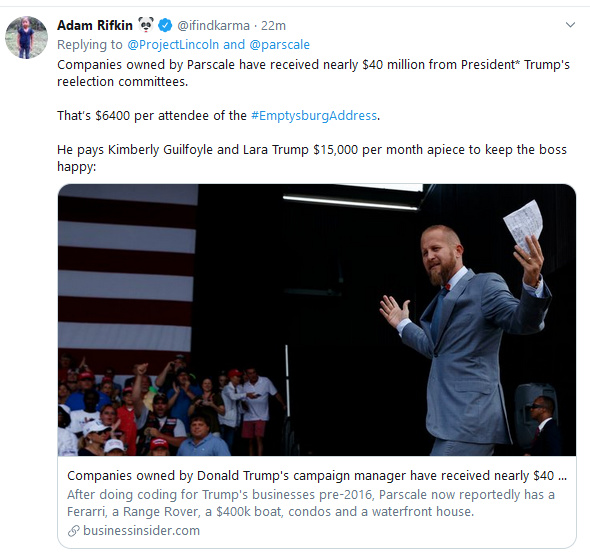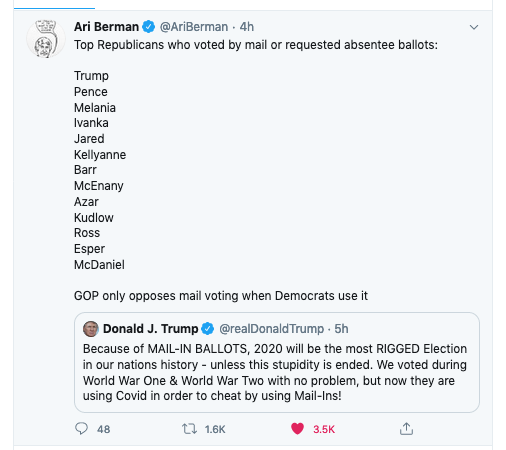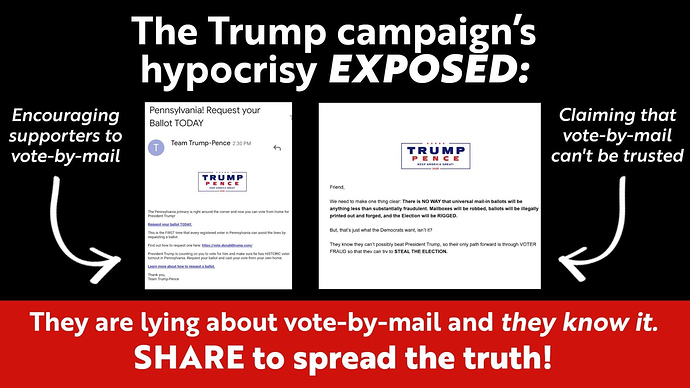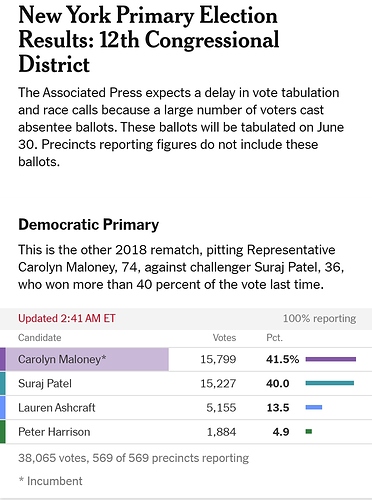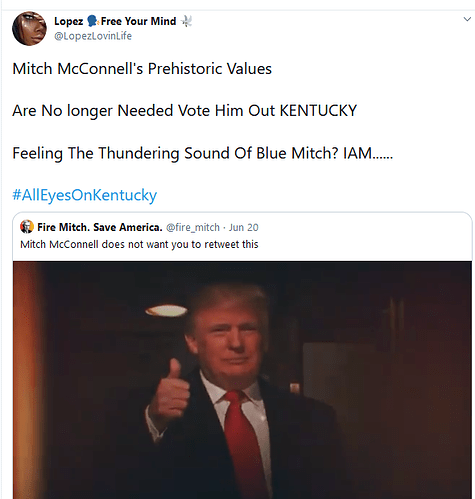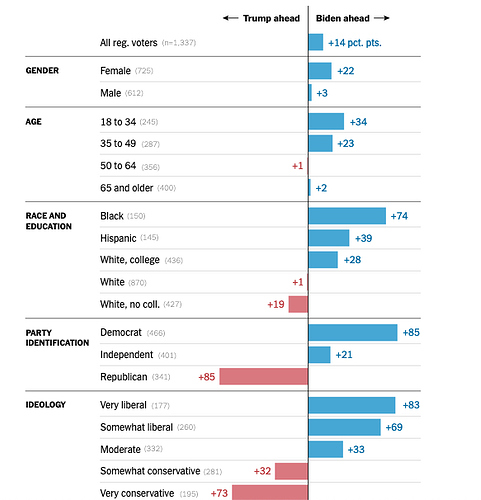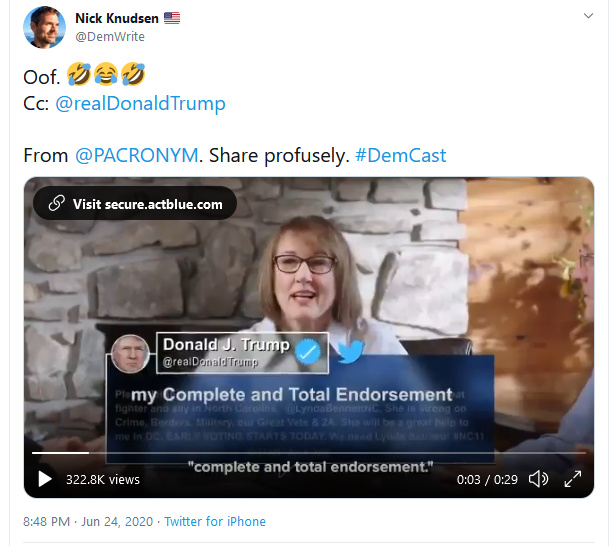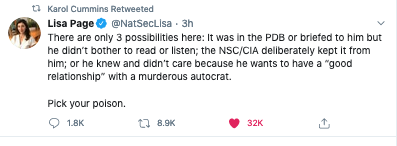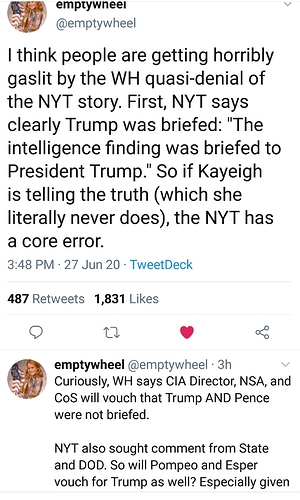Watch Nadler: House Judiciary to subpoena Attorney General Barr
Rep. Jerry Nadler, chairman of the House Judiciary Committee, tells Rachel Maddow that the committee is putting together a subpoena for Attorney General William Barr to testify in their investigation of corruption at the DOJ, suggesting that the DOJ budget could be used as leverage to compel Barr to comply.
FACT CHECK: Trump is once again spreading falsehoods about voting by mail, this time suggesting that foreign countries could print out and send in million of ballots.
Experts have called that “preposterous” and “false.”
The Trump campaign is encouraging its followers to vote by mail even as Trump and Pence claim it is not secure.
Latest Anti-T ad “Truth” from The Lincoln Project - 
Rep Carolyn Maloney won.
New York Primary Election Results: 12th Congressional District
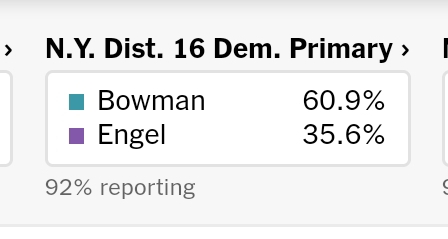
Also AOC won.
Rep Eliot Engel loses
Mr. Biden is currently ahead of Mr. Trump by 14 percentage points, garnering 50 percent of the vote compared with 36 percent for Mr. Trump. That is among the most dismal showings of Mr. Trump’s presidency, and a sign that he is the clear underdog right now in his fight for a second term.
…
Mr. Biden leads Mr. Trump by enormous margins with black and Hispanic voters, and women and young people appear on track to choose Mr. Biden by an even wider margin than they favored Hillary Clinton over Mr. Trump in 2016. But the former vice president has also drawn even with Mr. Trump among male voters, whites and people in middle age and older — groups that have typically been the backbones of Republican electoral success, including Mr. Trump’s in 2016.
If the 2020 presidential election were held today, whom would you vote for?
So, this is wild.
Longtime Democratic incumbent Eliot Engel has been primaried. He just opened an investigation, as head of the House Foreign Affairs Committee, with Carolyn Maloney, head of Oversight who barely hung on herself, into the firing of the State Dept. IG.
Engel to a fair degree took himself out, between being an absentee Rep. during the pandemic and a hot mic moment that hurt him badly.
There are three progressive, black candidates coming out of this as winners, including the one who took down Engel. All won by landslides.
Meanwhile, on the GOP side, Trump-backed candidates are losing left and right.
24-year old motivational speaker, Madison Cawthorn defeated Trump’s handpicked replacement for Mark Meadows, Lynda Bennett, in North Carolina.
https://www.charlotteobserver.com/news/politics-government/article243752012.html
In Kentucky, Trump tweeted his opposition to giving another term to a sitting congressman, Thomas Massie, who forced a vote on an economic relief package. Massie won overwhelmingly with almost 90% of the vote. Members of Republican leadership backed Massie’s primary opponent after Massie forced the vote. But after racist tweets surfaced from that opponent, Massie cruised.
The big one we’re still watching is progressive state Rep. Charles Booker vs. former Marine fighter pilot Amy McGrath for the right to take on Mitch McConnell in Kentucky.
Rambling pronouncements from T on Hannity last night which are for the most part what we’ve learned to expect from the T-Hannity arrangment -
Hannity - I punt vs T - I smooze without facts.
More underwhelming and often confusing statements from T to Hannity really suggest he is losing it. See “Portrait of a President”. @ddale8 Fact checks by CNN’s Daniel Dale
Even Tucker Carlson’s show ends with great skepticism.
Fox is not going to save T. Their polls say that too.
Hannity’s latest in-kind contribution to the Trump campaign was perfectly predictable, of course. The TV host, who is paid twenty-five million dollars a year by Fox, is so reliable a wingman to the President that my colleague Jane Mayer reported that Trump bragged he was a ten out of ten on the loyalty scale. Before the 2018 midterms, the President had Hannity appear onstage at his big pre-election rally, a faux pas even for Fox that earned Hannity a reprimand from his bosses. Before Thursday’s event, in Green Bay, Wisconsin, Trump hosted Hannity as his guest on Air Force One, and photographers snapped a picture of U.S. Marine guards saluting as Hannity walked on the tarmac to the plane’s steps. In a pre-town-hall interview, at a Wisconsin airplane hangar, the two looked like co-stars in a buddy movie; they were even dressed in matching long red ties and dark suits. When the show got going, Trump saluted Hannity as a “great journalist.” Hannity’s show is the Fox bunker that Trump retreats to when everything else is going wrong.
Not surprisingly, some of Trump’s most outrageous comments about the ongoing pandemic have been uttered on Hannity’s program. In early March, just a little over a week before he declared a national emergency and shut down the country, Trump told Hannity that the coronavirus was “very mild,” that it was similar to the annual flu, and that hundreds of thousands of people could recover from it while still going to work. On March 26th, the President touted the malaria treatment hydroxychloroquine as a miracle drug to combat the coronavirus. “This could be the big answer,” he told Hannity. On April 7th, Trump was back on the show, promoting himself and hydroxychloroquine. “We have millions of doses that I bought,” Trump said, before correcting himself, “that the country bought.” He added, “It’s not like it’s something unsafe.” A few weeks later, medical studies suggested that the drug was risky, and U.S. government health officials recommended it not be given to COVID -19 patients. The general theme of all these conversations with Hannity—which are better characterized as rambling monologues by Trump in which Hannity occasionally figures—has been the President’s increasingly urgent need to tout his own brilliance at handling the pandemic. “We’re way under . . . in terms of death,” he told Hannity, in April. But it wasn’t true, then or now.
In the past three months of the pandemic, Trump’s virus-spin cycle has become as familiar as it is mind-numbing, an endless loop of denial, magical thinking, blame-shifting, and fearmongering. Often, he seems to do all of this in the same day: We beat the invisible enemy. The country is transitioning to greatness. The virus is fading away. Cases are only going up because we are testing more. A miracle vaccine will be ready soon, probably, maybe, likely by the end of this year. People are wearing masks just because they want to hurt me politically and the media is lying to them. We did a great job. It’s the “kung flu.” It’s the “ChinaVirus.” These are all real points the President has made, just in the last few days.
…
No wonder Trump retreated to his Hannity bunker on Thursday, to talk about the border wall and Barack Obama’s “treason” and the deep state. About the “persecution” of Michael Flynn, and how much of a “disaster” his former Attorney general, Jeff Sessions, was. About the “rioters” and “terrorists” destroying America’s cities in the wake of George Floyd’s killing. This is a week when even Trump ought to have a hard time denying the reality of the disaster the country is facing, and his own political predicament. The virus is spiking in Republican-led states, such as Arizona, South Carolina, Arkansas, Florida, and Texas, which are must-wins for Trump in the fall. Texas alone reported six thousand new cases on Thursday, and its Republican governor, Greg Abbott, who had spent months aligned with Trump in downplaying the threat, is now urging state residents to shelter at home. On Thursday, he announced he was pausing the state’s plans to reopen. So did the equally pro-Trump Republican governor of Florida. Not exactly on-message for their President.
Shortly after 6 p.m. on Thursday, Trump sent out a tweet promoting his conversation with Hannity, taped earlier that day in Wisconsin, where a new Times poll shows him trailing Biden by eleven points. Minutes after Trump’s tweet, Fox News released the results of its own new poll in six key battleground states. It showed Trump behind Biden in every single one, including, for the first time in a Fox News poll, the Republican bastion of Texas. In the lead-up to Trump’s Hannity interview, the Tucker Carlson show opened with this banner: “ PRESIDENT TRUMP MAY LOSE THIS ELECTION .”
Democratic strategist James Carville calls it likes he sees it. - “Dems get off the conference calls and do something.” 
video
More than 1600 Polling Places Have Closed Since the Supreme Court Gutted the Voting Rights Act
Most of them are in minority communities.

In light of the news breaking yesterday about Russian paying Afghan’s/Taliban to kill American troops…a new ad from TLP.
Still no comment from WH regarding this revelation.
Video The Lincoln Project “Bounty”
But wait press Secretary T knew nothing at the time…and even with that he has had time to responds.
From Lisa Page (former FBI lawyer that T likes to kick around)
And most likely explanation…being gaslit again
Trump’s growing re-election threat: Republican skeptics
While President Donald Trump remains focused on outside antagonists, the threat from within could be decisive in an election that could be decided on the margins.
WASHINGTON — In 2016, Matt Borges publicly condemned and feuded with Donald Trump when he was head of the Ohio Republican Party — but in the end, he voted for him anyway. That won’t be happening in 2020.
Borges — who says he is confident there are a growing number of Republicans like him, unwilling to “hold their nose” and vote for Trump a second time — is part of a growing movement of conservatives openly working to elect the presumptive Democratic nominee, Joe Biden.
“Nothing was going to get me to vote for Hillary Clinton. I grew up in this business learning to fight against everything the Clintons were for. I knew her, and in my mind, I knew what a Clinton presidency was going to be like,” said Borges, who helped form an anti-Trump super PAC. “A lot of folks are like me. They understand that Joe Biden isn’t the same kind of candidate.”
While the president remains focused on outside foes, the threat from within could well prove a decisive factor this fall, with well-financed campaigns led by seasoned political operatives aimed at shaving away support from the GOP base in an election that could wind up being decided on the margins.
As lifelong conservatives, these members of the Republican resistance say they are in a unique position to reach like-minded voters who are uncomfortable with Trump’s rhetoric and actions but hesitant to back a Democrat.
“What we wanted to create is a movement among rank-and-file Republicans to give them a sense of community and a sense of encouragement from walking away from this president,” said Tim Miller, a former spokesman for the Republican National Committee. He is now an adviser to Republican Voters Against Trump, a super PAC that he said will “create a permission structure for them to say for the first, maybe only, time that they won’t vote for a Republican.”
Trump retains widespread support among Republicans in polls — 90 percent of those who identified as Republicans said they would vote for Trump, and 71 percent viewed him very favorably, according to a New York Times/Siena University poll released last week.
But Republicans advocating for Biden said cracks are forming that they believe they can tap into. Trump trailed Biden by 20 points among independent voters, the NYT/Siena poll found, and just 61 percent of self-identified Republicans said they viewed the country as being on the right track. The president’s support among the groups that were key to his win in 2016 — seniors, non-college-educated whites and men — has also been shrinking in multiple polls over the past two months.
The Lincoln Project, whose co-founders include Republican lawyer George Conway, the husband of top Trump adviser Kellyanne Conway, and veterans of multiple Republican presidential campaigns, has spent $2 million on ads attacking Trump and promoting Biden in battleground states, as well as in the nation’s capital — and it has earned much more than it has invested through Trump’s irritated public responses.
Republican Voters Against Trump expects to have a $10 million budget to target voters online, with a focus on college-educated Republicans in swing states and working-class female Republicans, said Miller, who is working with conservative commentator Bill Kristol on the project. The group has promoted hundreds of online videos of people who say they regret having voted for Trump in 2016 and won’t do the same in 2020, like a shirtless North Carolina man smoking a cigarette who professes that he would vote for a tomato can before voting again for Trump.
The group Borges helped start, Right Side PAC, is testing various messages and building out data models to identify persuadable Republican voters. Rather than run TV ads aimed at a large audience, it plans to target specific voters by mail, phone and online.
More groups are expected to emerge after the convention, said a GOP strategist who backed Trump in 2016 and is now opposing him. The operative said he has gotten calls from at least a half-dozen Republican consultants considering various anti-Trump efforts.
While no other president in recent history has faced such organized public opposition from within his own party, it’s not a new phenomenon for Trump, who has been contending with the so-called Never Trump movement among Republicans since he launched his campaign. Trump campaign communications director Tim Murtaugh dismissed the groups’ efforts, saying “any efforts by disgruntled former Republicans is doomed to fail.”
“President Trump has the support of a record number of Republicans and leads a united party,” Murtaugh said.
But in addition to the super PACs, a growing number of prominent Republicans are speaking out on their own, several of whom held top positions in his administration, such as former national security adviser John Bolton, a former Fox News contributor who has been lobbing near-daily attacks at Trump this month while promoting his book.
Anthony Scaramucci, a former Trump supporter who was briefly his White House communications director, has been working with Right Side PAC, reaching out to donors and trying to recruit other prominent Republicans to speak out, Borges said. Trump’s former chief of staff John Kelly and former defense secretary, James Mattis, have called Trump’s character into question over the past month.
Sen. Lisa Murkowski, R-Alaska, said this month that she was “struggling” with whether to support Trump. Other Republicans have been trying to sound the alarm with Trump about his weakening prospects, like Senate Majority Whip John Thune of South Dakota, who has said Trump should adjust his tone and has warned that support for the president among independents is softening.
Trump has been quick to punch back. He promised to campaign against Murkowski, and he called GOP critics “human scum” last year after several spoke out over his decision to withdraw U.S. troops from Syria and his attempts to pressure Ukrainian officials to investigate Biden’s son Hunter.
The anti-Trump Republican groups expect to raise just a fraction of the money as the pro-Trump super PAC or Biden-aligned PACs, but in an election that could come down to a few thousand votes in a single state, even getting Trump voters from 2016 to sit on the sidelines could be a victory.
“If you were for Trump last time and you write in Ronald Reagan this time, that is plus one for Joe Biden,” Miller said.
